1972 Israel IDF CULT FILM POSTER Movie AZIT The PARATROOPER DOG Hebrew JEWISH

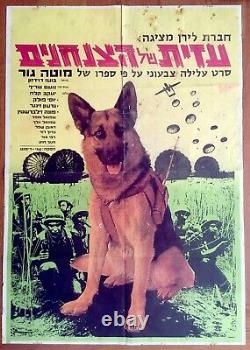
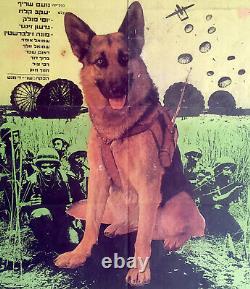
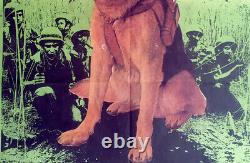
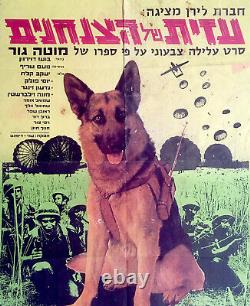
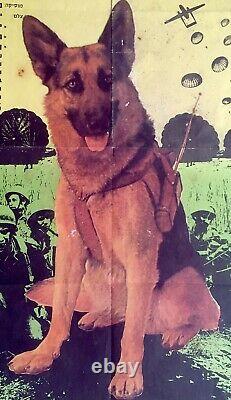
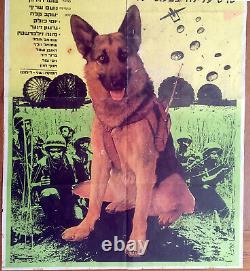
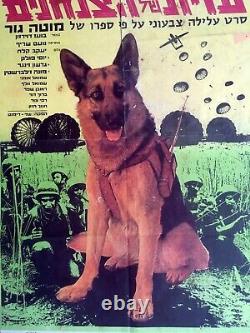


The story of AZIT the war dog who help the Israel IDF paratroopers in their military missions. Azit, intelligent German Shepherd dog of Tammy's - Paratroopers Lieutenant Uri girlfriend, rescues the wife of the neighborhood butcher from the wallets thief. After that, she is sent to a military training device which certifies her for parachute missions, detection and surveillance. Lieutenant Uri and Tami's dog Azit, saves the neighborhood butcher's wife from a burglar.
Following this act she is sent to a training course that prepares her for traking and detective work. Azit's first mission is to save a paratrooper and his girlfriend from the enemy territory. Based on the childrens' book of the same namy by MOTTA MORDECHAI GUR, The legendary CHIEF OF STAFF of the IDF.Directed by the legendary Israeli script writer, Producer but mainly a film director, one of the pioneers and leading directors of the BOUREKAS CULT FILM genre BOAZ DAVIDSON. Originaly published by the Israeli distributers.
Size around 39" x 27". Condition : Used with quite a few imperfections. Tears (Mended on the verso with a transparent tape).Hould be very attractive framed behind a framed glass (Please watch the scan for a reliable AS IS image). Poster will be sent rolled in a special protective rigid sealed tube. AUTHENTICITY : This poster is guaranteed ORIGINAL from 1972 , NOT a reprint or a recently made immitation. It holds a life long GUARANTEE for its AUTHENTICITY and ORIGINALITY. Were a genre of Israeli-made movies popular in Israel in the 1960s and 1970s.
Haaretz film critic Uri Klein describes Bourekas films as a peculiarly Israeli genre of comic melodramas or tearjerkers... "[1] They were "home-grown farces and melodramas that provided escapist entertainment during a tense period in Israeli history. "[2] The term is said to have been coined by the Israeli film director Boaz Davidson, the creator of several such films, as a play-on-words on the "spaghetti western genre, known as such because that particular Western sub-genre was produced in Italy. Bourekas is also a notable dish from Israeli cuisine.
Gefilte-fish Films "Gefilte-Fish" films, also known as "bourekas for Ashkenazim" are a maringal group of Bourekas films that feature Ashkenazi protagonists and ghetto folklore. [3] Some films in this sub-genre include: Kuni Lemel, 1968 (Israel Bekers) Lupo, 1970 (Golan) Kuni Lemel in Tel Aviv (1976) (Yoel Zilberg) Lupo in New York (1976) (Davidson) Hershele, 1977 (Yoel Zilberg) Marriage Tel Aviv Style, 1980 (Yoel Zilberg) Aunt Klara (HaDoda Klara), 1977 (Avraham Hefner) Themes The main theme in most Bourekas films is the conflict between ethnic cultures in Israel, in particular between the Mizrahi Jews and the Ashkenazi Jews.
The hero is usually a Mizrahi Jewish man, almost always poor, canny and with street smarts, who comes into conflict with the institutions of the state or figures of Ashkenazi origin - mostly portrayed as rich, conceited, arrogant, cold-hearted and alienated. In many of these films, actors imitate different Hebrew accents, especially that of Jews originating from Morocco, Persia and Poland. They employ slapstick humour, alternate identities and a combination of comedy and melodrama. In a paper entitled "A Shtetl in Disguise: Israeli Bourekas Films and their Origins in Classical Yiddish Literature, " Rami Kimchi claims that the portrayal of Israeli Mizrahi communities in these films bears a strong resemblance to the portrayal of the 19th century East European shtetl by classic Yiddish writers. [4] Kimchi attributes the commercial success of these films to their "hybridity, " i. They were Israeli/Mizrahi and Diasporic/Ashkenazi at one and the same time, thereby satisfying the political, sociological, and psychological needs of both Mizrahi and Ashkenazi audiences in Israel. [5] He believes eleven films produced between 1964 and 1977 make up the corpus of the genre. [6] Actors and directors Bourekas films were highly successful in Israel during the 1960s and 1970s, but were also criticized for being shallow. Some of the main actors and directors were: Ze'ev Revach - an actor and director who participated in many popular Bourekas film comedies such as Hagiga B'Snuker (1975), Charlie Ve'hetzi (1974), Rak Hayom (1976), Gonev Miganav Patoor (1977), Ta'ut Bamispar (1979), Ha-Muvtal Batito (1987), Lo La'alot Yoter (1979), Sapar Nashim (1984), Pa'amaim Buskila (1998), and more. Revach eventually became the person which is most identified with the Bourekas films and continued to create those films until the end of the 1980s. George Obadiah - a director who created many melodramas which were influenced (and at times copied) from the Turkish cinema. The most prominent of his films are : Ariana (1971), Nurit (1972), Sarit (1974), Na'arat haparvarim (1979), and more. Obadiah created also comedies like Nahtche V'Hageneral (1972), Fishke Bemilu'im (1971) and Koreyim Li Shmil (1973). Yehuda Barkan - an actor and director who participated in many Bourekas films such as Lupo (1970) and Lupo B'New York (1976), Katz V'Carasso (1971), Charlie Ve'hetzi (1974), Hagiga B'Snuker (1975), Bo Nefotzetz Million (1977) and more. Barkan also played in the 1980s Abba Ganuv film series and directed them. Boaz Davidson - a director of many Bourekas film comedies such as Charlie Ve'hetzi (1974), Hagiga B'Snuker (1975), Mishpahat Tzan'ani (1976), and Lupo B'New York (1976). His films Charlie Ve'hetzi and Hagiga B'Snuker had a'revival' in the 1990s and a status of Israeli cult film status. Yosef Shiloach - Played in several Bourekas film comedies, in parallel with a set of dramatic and more serious roles he played in a variety of Hollywood films. A character which is identified with him in particular is "the Persian" - a somewhat sensual grotesque who possesses a strong Persian accent. Tuvia Tzafir - Played in several Bourekas films, particularly in the role of the grotesque "Ashkenazi" character. Menahem Golan - a director and producer of many fiscally successful Bourekas films such as Lupo (1970), Fortuna (1966), My Margo (1969), and Queen of the Road (Malkat haKvish) (1971). Films Several prominent Bourekas films are listed below in chronological order of production. They were cited as "low-brow" and "vulgar", with great concern as to this genre of film representing the Israeli people abroad. [7] In critiquing Sallah Shabbati Biltzki in Al hoMishmar said, Because parties in Israel are presented not only in the distorted mirror of a distorted humor but also in the ugly mirror of the image of public and organizational life...One has to think twice if such a film should represent us abroad. [8] Demise of the genre At the end of the 1970s, the popularity of the Bourekas film declined.
In the 1980s, Israeli films became more politically charged and began to address controversial topics. Nowadays many of the Bourekas films have gained cult status in Israel.
Were a film genre popular in the 1960s and 1970s. Central themes include ethnic tensions between the Ashkenazim and the Mizrahim or Sephardim and the conflict between rich and poor.
[12] The term was supposedly coined by the Israeli film director Boaz Davidson, the creator of several such films, [13] as a play-on-words, after "Spaghetti Western:" just as the Western sub-genre was named after a notable dish of its country of filming, so the Israeli genre was named after the notable Israeli dish, Bourekas. [citation needed] Bourekas films are further characterized by accent imitations (particularly of Jewish people originating from Morocco, Persia, and Poland); a combination of melodrama, comedy and slapstick; and alternate identities. [citation needed] Bourekas films were successes at the box office but panned by the critics. They included comedy films such as Charlie Ve'hetzi and Hagiga B'Snuker and sentimental melodramas such as Nurit. Prominent filmmakers in this genre during this period include Boaz Davidson, Ze'ev Revach, Yehuda Barkan and George Ovadiah. May 6, 1930 - July 16, 1995 was an Israeli politician and the 10th Chief of Staff of the IDF. During the Six-Day War (1967), he commanded the division that penetrated the Old City of Jerusalem and broadcast the famous words, The Temple Mount is in our hands! [1] As Chief of Staff, he had responsibility for planning and executing Operation Entebbe (1976) to free Jewish hostages in Uganda. He later entered the Knesset and held various ministerial portfolios. He contracted terminal cancer and committed suicide at the age of 65. Military careerGur was born in Jerusalem and later joined the Palmach Haganah (the underground armed group of the Jews in the British Mandate of Palestine). He continued serving in a military capacity with the founding of the Israel Defense Forces (IDF) during the Israeli War of Independence in 1948. [1]In the IDF, Gur served in the Paratroopers Brigade most of his career and became one of the symbols of the "red beret" brigade. During the 1950s he was a company commander under the command of Ariel Sharon.He was wounded during a counter-terror raid in Khan Yunis in 1955 and received a recommendation of honor from Chief of Staff Moshe Dayan. In 1957 he was appointed as adjutant to the brigade commander.
After serving in this position Gur went to study at the École Militaire in Paris. He brought over the traditions and attitude of the Paratroopers, raised morale, and helped instill an espirit de corps in Golani for which the brigade is still famous.
In 1965 he was appointed as the head of the operations branch in the general staff of the IDF. Gur and his troops were part of the assault force which wrested Jerusalem from the Jordanians, and which were the first to visit the Western Wall and the Temple Mount. The pictures of paratroopers crying at the Wall and Gur's audio recording in the communication networks, The Temple Mount is in our hands! , became one of the most touching symbols of the war to the Israeli public. After the war he was promoted to Brigadier General's rank and was appointed as the IDF commander in the Gaza Strip and northern Sinai Peninsula.
In 1969 he was promoted to Major General and was appointed as the commander of the northern front, where Palestinian terrorists from the PLO, backed by Syria, attacked Israel's northern settlements. Gur led several counter-attacks to reign in the terror attacks, conquering the Shebaa farms from Syria in order to establish a defensive position to prevent border attacks. From August 1972 to December 1973 he served as the IDF military attache at Israel's Washington D.
In January 1974 he was reappointed as the commander of the northern front. Following the retirement of General David Elazar due to the criticism of the Agranat Commission he was appointed in April 1974 as the 10th IDF Chief of Staff. He served in that position until 1978. [1]Civilian and political careerFollowing his retirement from the IDF, Gur was appointed as the general manager of Kur Mechanica company. In 1981 he was elected to the Knesset as a member of the Labor Party within the Alignment. Re-elected in 1984, he served as Minister of Health and was also a member of the Knesset's Security and Foreign Affairs Committee. Between 1986 and 1988 he served on the board of Solel Boneh, a construction company. In April 1988 he was appointed Minister without Portfolio, a position he retained following the 1988 elections until March 1990, when Labor pulled out of the coalition. After the Labor Party won the 1992 elections, Gur was appointed Deputy Minister of Defense, responsible for preparing the Israeli economy for times of war and crisis and interacting with the Jewish settlers in West Bank and Gaza Strip. DeathIn 1995, Gur became seriously ill with terminal cancer. He committed suicide with a handgun on July 16, 1995 at the age of 65. [1]Area 21, a military base in the Sharon plain, was renamed in his honour (Camp Motta Gur).In Modiin a street and a school was named after Gur. BibliographyHar HaBayit BeYadeinu (literally "The Temple Mount is in our hands") (The Battle for Jerusalem), 1974.
Azit Hakalba Hatzanhanit (1972) Azit the Paratrooper Dog AKA Azit: Canine Paratrooper (Azit Hakalba Hatzanhanit) Azit, intelligent German Shepherd dog of Tammy's - Paratroopers Lieutenant Uri girlfriend, rescues the wife of the neighborhood butcher from the wallets thief. A Film by Boaz Davidson (Israel, 1972, 89 Minutes, Color, Hebrew, English subtitles, Cast: Yossi Polak, Mona Zelberstein, Gidon Zinger, Eliezer Yung, Tikva Aziz) The film is based on a children's book written by Motta Gur, the commander who led the liberation of Jerusalem in'67 and later became IDF Chief of Staff.
It tells the tale of a super-talented German shepherd who gets sent to a paratroop unit to be trained for combat operations. When her owner is captured by Arab terrorists, Azit is called into action to save him. Azit, the Paratrooper Dog (1972) movie was based on a children's book by Mordechai "Motta" Gur. Although Azit was a fictional character, there have been real-life parachuting war dogs for many years, starting as early as WWI. Read about other amazing canine heros depicted on the silver screen in Wonder Dogs: 101 German Shepherd Dog Films. Azit -- the devoted and intelligent dog of an Israeli army lieutenant -- shows her bravery during a robbery and earns a spot in her owner's paratroopers division.But when the lieutenant is captured, the dog risks everything to rescue her owner. Can she deliver on her toughest mission ever? Yossi Pollak, Mona Silberstein, Gideon Singer, Tikva Aziz and Baruch David star in this Israeli action film directed by Boaz Davidson. Born 8 November 1943 is an Israeli film director, producer and screenwriter. He was born in Tel Aviv, Israel and studied film in London.
[1] Davidson started his career by directing the television show Lool (1969) and the movie Shablul (1971). Later he directed Israeli cult films such as Charlie Ve'hetzi (1974) and Hagiga B'Snuker (1975). In 1974 he directed the film Mishpahat Tzan'ani.
He directed the first four films in the Eskimo Limon series Eskimo Limon (1978), Yotzim Kavua (1979), Shifshuf Naim (1981), Sapiches (1982). Eskimo Limon was entered into the 28th Berlin International Film Festival in 1978. [2] In 1983, Davidson directed Basis Sababa which is based on Sapiches. In 1986 he directed the cult film Alex Holeh Ahavah.
In 1979 Davidson moved from Israel to the United States and started working as a director, directing a remake of Eskimo Limon, The Last American Virgin in 1982. [3] Davidson continued to work in the United States as a producer and a screenwriter. He was involved in producing several major films including 16 Blocks, The Wicker Man, The Black Dahlia, 2008's Rambo and The Expendables. He is also listed as a producer in the thriller Trespass. Filmography Hercules: The Legend Begins (2014) - Producer Criminal (2015) - Producer · Mivtza Yonatan (also known as Entebbe: Operation Thunderbolt and Operation Thunderbolt), Cinema Shares International, 1977 · The Alternate (also known as Agent of Death), Lions Gate Films, Inc.
1998 (Uncredited) Donuts, 1998 Film Producer Ochlim Lokshim (also known as Crazy Camera), 1989 (With Christopher Pearce and Elie Cohn) Human Shield, 1991 Tipat Mazal (also known as A Bit of Luck), 1992 Lelakek Tatut (also known as Licking the Raspberry), 1992 Dogs in warfare have a long history starting in ancient times. From'war dogs' trained in combat to their use as scouts, sentries and trackers, their uses have been varied and some continue to exist in modern military usage. HistoryWar dogs were used by the Egyptians, Greeks, Persians, Sarmatians, Alans, Slavs, Britons, and the Romans. [1][2] The Molossus dog of the Molossia region of Epirus was the strongest known to the Romans, and was specifically trained for battle. [3] Among the Greeks and Romans, dogs served most often as sentries or patrols, though they were sometimes taken into battle.
[4] The earliest use of war dogs in a battle recorded in classical sources was by Alyattes of Lydia against the Cimmerians around 600 BC. The Lydian dogs killed some invaders and routed others. [citation needed]During the Late Antiquity, Attila the Hun used giant Molosser dogs in his campaigns. Other civilizations used armored dogs to defend caravans or attack enemies. The Spanish conquistadors used armored dogs that had been trained to kill natives. [6]In the Far East, Emperor Lê L? I raised a pack of 100 hounds, this pack was tended and trained by Nguy? N Xí whose skills was impressive enough to promote him to the Commander of a shock troop regiment. Later on, Frederick the Great used dogs as messengers during the Seven Years' War with Russia. Napoleon also used dogs during his campaigns.Dogs were used up until 1770 to guard naval installations in France. [citation needed]The first official use of dogs for military purposes in the United States was during the Seminole Wars. [1] Hounds were used in the American Civil War to protect, send messages, and guard prisoners[7] Dogs were also used as mascots in American World War I propaganda and recruiting posters.
During this period the Doberman Pinscher became the official dog of the USMC; however, all breeds of dogs were eligible to train to be "war dogs of the Pacific". Many of the dogs went home with their handlers from the war.[19] Chips was the most decorated war dog during World War II. 232 military working dogs[20] and 295[21] US servicemen working as dog handlers were killed in action during the war.
It is estimated that about 200 Vietnam War dogs survived the war to be assigned at other US bases outside the US. The remaining canines were euthanized or left behind. [22][23]2011: United States Navy SEALs used a Belgian Malinois military working dog named Cairo in Operation Neptune Spear, in which Osama bin Laden was killed. [24][25]RolesDogs have been used for many different purposes. Different breeds were used for different things, but always met the demands of the handlers.
Many roles for dogs in war are obsolete and no longer practiced, but the concept of the war dog still remains alive and well in modern warfare. FightingIn ancient times, dogs, often large mastiff- or molosser-type breeds, would be strapped with armor or spiked collars and sent into battle to attack the enemy. This strategy was used by various civilizations, such as the Romans and the Greeks. This approach has been largely abandoned in modern day militaries due to the fact that modern weapons would allow the dogs to be killed almost immediately, as on Okinawa when U. Soldiers quickly eliminated a platoon of Japanese soldiers and their dogs. [26]Another program attempted during World War II was suggested by a Swiss citizen living in Santa Fe, New Mexico. Prestre proposed using large dogs to kill Japanese soldiers. He convinced the military to lease an entire island in the Mississippi to house the training facilities. There the army hoped to train as many as two million dogs. The idea was to begin island invasions with landing craft releasing thousands of dogs against the Japanese defenders, then followed up by troops as the Japanese defenders scattered in confusion. One of the biggest problems encountered was getting Japanese soldiers to train the dogs with, as few Japanese soldiers were being captured. Eventually, Japanese-American soldiers volunteered for the training.The biggest problem was with the dogs; either they were too docile, did not properly respond to their beach crossing training, or were terrified by shellfire. After millions of dollars spent and inconclusive results, the program was abandoned. [27]The Soviet Union used dogs for anti-tank purposes beginning in the 1930s.
Earlier anti-tank dogs were fitted with tilt-rod mines and trained to run beneath enemy tanks, which would detonate the mines automatically. However, the dogs were trained with stationary Russian tanks and very seldom ran under moving tanks, instead being shot as they ran beside moving tanks. When both Russian and German tanks were present, the dogs would preferentially run towards the familiar Russian tanks.Logistics and communicationAbout the time World War I broke out, many European communities used dogs to pull small carts for milk deliveries and similar purposes. [28] Several European armies adapted the process for military use. [29] In August 1914, the Belgian Army used dogs to pull their Maxim Guns on wheeled carriages and supplies or reportedly even wounded in their carts. [30] The use of dogs for this purpose ceased with the advent of trench warfare after the first two months of the conflict. The French had 250 dogs at the start of World War I.
The Dutch army copied the idea and had hundreds of dogs trained and ready by the end of World War I (the Netherlands remained neutral). The Soviet Red Army also used dogs to drag wounded men to aid stations during World War II.[31] The dogs were well-suited to transporting loads over snow and through craters. Dogs were often used to carry messages in battle. They would be turned loose to move silently to a second handler.
This required a dog that was very loyal to two masters, otherwise the dog would not deliver the message on time or at all. Some messenger dogs also performed other communication jobs, such as pulling telephone lines from one location to another.[citation needed]MascotsMain article: Military mascotDogs were often used as unit mascots for military units. The dog in question might be an officer's dog, an animal that the unit chose to adopt, or one of their canines employed in another role as a working dog. Some naval dogs such as Sinbad and Judy were themselves enlisted service members. Some units also chose to employ a particular breed of dog as their standard mascot, with new dogs replacing the old when it died or was retired.
The presence of a mascot was designed to uplift morale, and many were used to this effect in the trenches of World War I. Medical researchMain article: Animal testingIn World War II, dogs took on a new role in medical experimentation, as the primary animals chosen for medical research.
[32] The animal experimentation allowed doctors to test new medicine without risking human lives, though these practices came under more scrutiny after the war. The United States' government responded by proclaiming these dogs as heroes. The Cold War sparked a heated debate over the ethics of animal experimentation in the U. Particularly aimed at how canines were treated in World War II.[32] In 1966, major reforms came to this field with the adoption of the Laboratory Animal Welfare Act. [33]Detection & trackingMain article: Detection dogMany dogs were used to locate mines. They did not prove to be very effective under combat conditions.
Marine mine detecting dogs were trained using bare electric wires beneath the ground surface. [34] The wires shocked the dogs, teaching them that danger lurked under the dirt. Once the dog's focus was properly directed, dummy mines were planted and the dogs were trained to signal their presence. While the dogs effectively found the mines, the task proved so stressful for the dogs they were only able to work between 20 and 30 minutes at a time.
The mine detecting war dogs anticipated random shocks from the heretofore friendly earth, making them extremely nervous. [clarification needed] The useful service life of the dogs was not long. Experiments with lab rats show that this trend can be very extreme, in some tests rats even huddled in the corner to the point of starvation to avoid electric shock. Some dogs are trained to silently locate booby traps and concealed enemies such as snipers. The dog's keen senses of smell and hearing would make them far more effective at detecting these dangers than humans.
The best scout dogs are described as having a disposition intermediate to docile tracking dogs and aggressive attack dogs. [35]Scout dogs were used in World War II, Korea, and Vietnam by the United States to detect ambushes, weapon caches, or enemy fighters hiding underwater, with only reed breathing straws showing above the waterline.
The US operated a number of scout dog platoons (assigned on a handler-and-dog team basis to individual patrols) and had a dedicated dog training school in Fort Benning, Georgia. [35]SentriesMain article: Guard dogOne of the earliest military-related uses, sentry dogs were used to defend camps or other priority areas at night and sometimes during the day. They would bark or growl to alert guards of a stranger's presence.
During the Cold War, the American military used sentry dog teams outside of nuclear weapons storage areas. A test program was conducted in Vietnam to test sentry dogs, launched two days after a successful Vietcong attack on Da Nang Air Base (July 1, 1965). Forty dog teams were deployed to Vietnam for a four month test period, with teams placed on the perimeter in front of machine gun towers/bunkers. The detection of intruders resulted in a rapid deployment of reinforcements.The buildup of American forces in Vietnam created large dog sections at USAF Southeast Asia (SEA) bases. 467 dogs were eventually assigned to Bien Hoa, Binh Thuy, Cam Ranh Bay, Da Nang, Nha Trang, Tuy Hoa, Phu Cat, Phan Rang, Tan Son Nhut, and Pleiku Air Bases. Within a year of deployment, attacks on several bases had been stopped when the enemy forces were detected by dog teams. Captured Vietcong told of the fear and respect that they had for the dogs. The Vietcong even placed a bounty on lives of handlers and dogs.
The success of sentry dogs was determined by the lack of successful penetrations of bases in Vietnam and Thailand. It is estimated by the United States War Dogs Association that war dogs saved over 10,000 U. [36] Sentry Dogs were also used by the Army, Navy, and Marines to protect the perimeter of large bases. Modern usesContemporary dogs in military roles are also often referred to as police dogs, or in the United States as a Military Working Dog (MWD), or K-9.
Their roles are nearly as varied as their ancient cousins, though they tend to be more rarely used in front-line formations. As of 2011, 600 U. Military dogs were actively participating in the conflicts in Iraq and Afghanistan. [37]Traditionally, the most common breed for these police-type operations has been the German Shepherd; in recent years there has been a shift to smaller dogs with keener senses of smell for detection work, and more resilient breeds such as the Belgian Malinois and Dutch Shepherd for patrolling and law enforcement. All MWDs in use today are paired with a single individual after their training. This person is called a handler. While a handler usually won't stay with one dog for the length of either's career, usually a handler will stay partnered with a dog for at least a year, and sometimes much longer. The latest canine tactical vests are outfitted with cameras and durable microphones that allow dogs to relay audio and visual information to their handlers. [38]In the 1970s the US Air Force used over 1,600 dogs worldwide. Today, personnel cutbacks have reduced USAF dog teams to approximately 530, stationed throughout the world. Many dogs that operate in these roles are trained at Lackland Air Force Base, the only United States facility that currently trains dogs for military use. [39]Change has also come in legislation for the benefit of the canines. Prior to 2000, older war dogs were required to be euthanized. The new law permits adoption of retired military dogs. [39] One notable case of which was Lex, a working dog whose handler was killed in Iraq. There are numerous memorials dedicated to war dogs, including March Field Air Museum in Riverside, California;[40] the Infantry School at Fort Benning, Georgia;[40] at the Naval Facility, Guam, with replicas at the University of Tennessee College of Veterinary Medicine in Knoxville;[41] the Alfred M. Gray Marine Corps Research Center in Quantico, Virginia;[42] and the Alabama War Dogs Memorial at the USS Alabama Battleship Memorial Park in Mobile, Alabama. [43]Law enforcementAs a partner in everyday military police work, dogs have proven versatile and loyal officers. Police dogs can chase suspects, track them if they are hidden, and guard them when they are caught. They are trained to respond viciously if their handler is attacked, and otherwise not to react at all unless they are commanded to do so by their handler. Many police dogs are also trained in detection as well. Drug and explosives detectionMain article: Detection dogBoth MWDs and their civilian counterparts provide service in drug detection, sniffing out a broad range of psychoactive substances despite efforts at concealment. Provided they have been trained to detect it, MWDs can smell small traces of nearly any substance, even if it is in a sealed container.Dogs trained in drug detection are normally used at ports of embarkation such as airports, checkpoints, and other places where there is high security and a need for anti-contraband measures. MWDs can also be trained to detect explosives. As with narcotics, trained MWDs can detect minuscule amounts of a wide range of explosives, making them useful for searching entry points, patrolling within secure installations, and at checkpoints. These dogs are capable of achieving over a 98% success rate in bomb detection. [44]IntimidationThe use of Military Working Dogs on prisoners by the United States during recent wars in Afghanistan and Iraq has been controversial.
Has used dogs to intimidate prisoners in Iraqi prisons. [45] In court testimony following the revelations of Abu Ghraib prisoner abuse, it was stated that Col. Pappas approved the use of dogs for interrogations.Frederick testified that interrogators were authorized to use dogs and that a civilian contract interrogator left him lists of the cells he wanted dog handlers to visit. They were allowed to use them to...
Smith, were then charged with maltreatment of detainees, for allegedly encouraging and permitting unmuzzled working dogs to threaten and attack them. Prosecutors have focused on an incident caught in published photographs, when the two men allegedly cornered a naked detainee and allowed the dogs to bite him on each thigh as he cowered in fear. [46]Guantanamo Bay: It is believed that the use of dogs on prisoners in Iraq was learned from practices at Guantanamo Bay Naval Base.
[46] The use of dogs on prisoners by regular U. Forces in Guantanamo Bay Naval Base was prohibited by Donald Rumsfeld in April 2003.
A few months later following revelations of abuses at Abu Ghraib prison, including use of dogs to terrify naked prisoners; Rumsfeld then issued a further order prohibiting their use by the regular U. The Vietnam War was different in that US war dogs were designated as expendable equipment and were either euthanized or turned over to an allied army prior to the US departure from South Vietnam. [48] Due to lobbying efforts by veteran dog handlers from the Vietnam War Congress approved a bill allowing veteran US military working dogs to be adopted after their military service. In 2000, President Bill Clinton signed a law that allowed these dogs to be adopted, [49] making the Vietnam War the only American war in which US war dogs never came home. [23][50]Other rolesMilitary working dogs continue to serve as sentries, trackers, search and rescue, scouts, and mascots. Retired working dogs are often adopted as pets or therapy dogs. This item is in the category "Collectibles\Religion & Spirituality\Judaism\Images". The seller is "judaica-bookstore" and is located in this country: IL. This item can be shipped worldwide.- Country/Region of Manufacture: Israel
- Religion: Judaism


